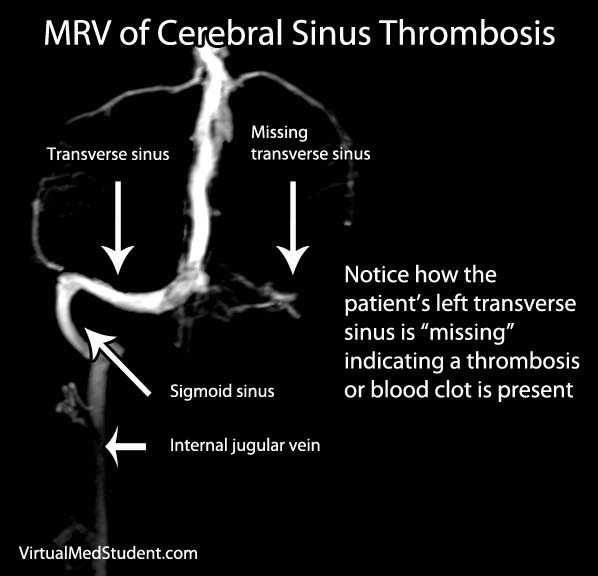In order to understand cerebral sinus thrombosis, we need a quick overview of blood vessel anatomy and the normal direction of blood flow in the body. In the most general terms, blood flows from the heart to large arteries (ie: aorta) then smaller arteries (branches off the aorta) then even smaller vessels called capillaries. It is at this point where the different body tissues extract nutrients and oxygen from the blood. The blood then drains into progressively larger veins until it empties back into the heart where it is re-oxygenated.
The largest veins of the brain are referred to as cerebral venous sinuses. They include the superior sagittal sinus, inferior sagittal sinus, a pair of transverse sinuses, a pair of sigmoid sinuses, straight sinus, cavernous sinus, a pair of superior petrosal sinuses, a pair of inferior petrosal sinuses, and the occipital sinus. The role of these sinuses is to collect all the “used” blood from the brain and deliver it back to the heart.
Like other veins in the body, the cerebral sinuses can form blood clots in them (the technical term for a blood clot is actually a "thrombosis", hence the name “sinus thrombosis”). When this happens a back up of blood in the brain occurs leading to increased pressure and sometimes hemorrhage within the brain tissue itself.
The exact cause of a dural venous thrombosis is not always clear. However, there are numerous risk factors associated with their development. They include inherited defects in proteins responsible for blood clot formation. These defects are collectively known as “thrombophilias”, which in Latin means “thrombus loving”. People with these inherited issues are more prone to forming blood clots.
In addition, patients with a kidney condition known as nephrotic syndrome are at increased risk. In this condition patients urinate out proteins responsible for keeping the blood clotting system at bay. The resulting imbalance can cause blood clots to form where they normally would not.
Infections such as mastoiditis and meningitis can cause inflammation of the sinuses, which can result in blood clot formation. Trauma to the head can also cause clot formation. In addition, that beautiful parasitic infection known as pregnancy (a joke of course!) also increases the risk of developing blood clots. Many commonly used birth control pills, especially those containing estrogen, can also increase a person’s risk.
Signs and Symptoms
Depending on the severity of the clot, everything from a mild headache (the most common presenting symptom) to death is possible. Patients with severe headaches may also have associated nausea and vomiting secondary to elevated intracranial pressures. Decreased mental status is also sometimes observed.
It is also important to remember that not all sinuses are created equal. For example, thrombosis in the superior sagittal sinus can present with leg weakness secondary to edema (ie: swelling) of the adjacent motor cortex.
If a clot forms in the cavernous sinus it may cause dysfunction of the third, fourth, fifth, and/or sixth cranial nerves. In addition, when blood pools in the brain behind the clot it can result in a type of stroke known as venous infarction.
Diagnosis
With todays modern imaging studies, MRI, and more specifically, MR venography has become a crucial diagnostic aid.
An example of an MR venogram is shown in the picture below. Other commonly used tests include traditional angiograms, in which radio-opaque dye is injected directly into the sinuses through catheters inserted in the groin. Finally, CT scans are also commonly obtained, especially to evaluate for possible co-existent hemorrhage into the brain.

Treatment
Treatment is usually with a blood thinning medication known as heparin. It is delivered through an IV and helps prevent further clot formation. If a venous stroke is present the use of blood thinning medications must be weighed against the possibility of causing bleeding into the stroked brain tissue. Aggressive hydration with normal saline is also often advocated.
Treating other underlying co-problems such as seizures and increased intracranial pressure is also an important part of managing patients with cerebral sinus thrombosis. Patients with substantial increases in intracranial pressure may require removal of the skull (craniectomy).
Overview
Cerebral sinus thrombosis is a abnormal blood clot in one of the large venous draining systems of the brain. They are uncommon and can present with everything from a mild headache to coma and death. Diagnosis is made most commonly with MRI. Treatment is based on preventing further clot formation with heparin and aggressive hydration.
References and Resources
- Xu H, Chen K, Lin D, et al. Cerebral venous sinus thrombosis in adult nephrotic syndrome. Clin Nephrol. 2010 Aug;74(2):144-9. Review.
- Dlamini N, Billinghurst L, Kirkham FJ. Cerebral venous sinus (sinovenous) thrombosis in children. Neurosurg Clin N Am. 2010 Jul;21(3):511-27.
- Ju YE, Schwedt TJ. Abrupt-onset severe headaches. Semin Neurol. 2010 Apr;30(2):192-200. Epub 2010 Mar 29.
- Kamal AK. Thrombolytic therapy in cerebral venous sinus thrombosis. J Pak Med Assoc. 2006 Nov;56(11):538-40.
- Greenberg MS. Handbook of Neurosurgery. Sixth Edition. New York: Thieme, 2006.